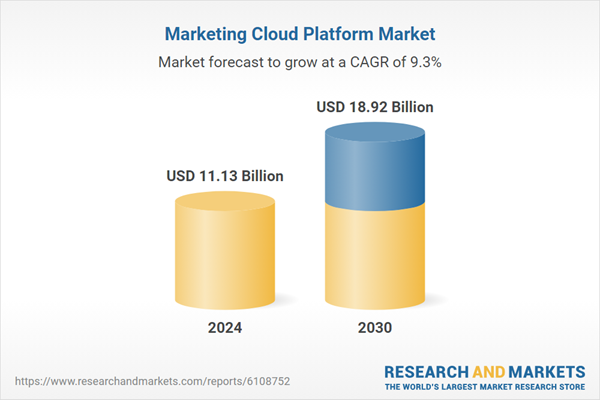Speak directly to the analyst to clarify any post sales queries you may have.
10% Free customizationThis report comes with 10% free customization, enabling you to add data that meets your specific business needs.
Key Market Drivers
Surge in Demand for Personalized Customer Experiences
The demand for personalization has become a central driver of the marketing cloud platform market. As digital-savvy consumers expect tailored experiences across all touchpoints, businesses are adopting cloud-based marketing platforms to gather and analyze customer data for precise targeting. These platforms enable marketers to craft campaigns based on individual behavior, preferences, and purchase history. With integrated tools like machine learning and real-time segmentation, businesses can orchestrate customer journeys that are timely and relevant. Personalization not only boosts engagement but also improves conversion rates and brand loyalty. A 2024 Adobe Digital Trends Report highlighted that nearly 90% of marketers identified personalization as a top priority, underscoring the critical role of marketing cloud platforms in supporting scalable, data-driven engagement strategies.Key Market Challenges
Data Privacy Regulations and Compliance Complexity
The tightening of global data privacy laws presents a substantial challenge for marketing cloud platform adoption. Regulations such as the GDPR in Europe, CCPA in the U.S., and similar laws in other regions impose strict requirements on how consumer data is collected, used, and stored. Ensuring compliance requires significant operational adjustments, legal oversight, and technical adaptations within marketing operations. Enterprises must now integrate consent management, data transparency, and secure processing frameworks into every customer interaction. For global organizations, the fragmented nature of these regulations across jurisdictions adds to the complexity, limiting the scalability of unified cloud strategies. Sectors handling sensitive data - such as healthcare and finance - are particularly cautious, often delaying full-scale adoption due to regulatory uncertainty and the risk of penalties.Key Market Trends
Surge in Artificial Intelligence Integration for Hyper-Personalization
A transformative trend in the marketing cloud platform space is the integration of artificial intelligence to enable hyper-personalized engagement. AI technologies, including machine learning, predictive analytics, and natural language processing, are being embedded into cloud platforms to automate segmentation, forecast behavior, and optimize campaign performance.This allows marketers to deliver highly targeted content and experiences at scale. AI also supports dynamic content generation, chatbot interactions, and sentiment analysis - enhancing customer journeys across all digital channels. As brands compete for customer attention in a saturated digital ecosystem, AI becomes essential for delivering responsive, data-informed strategies. Marketing cloud vendors are prioritizing AI advancements to differentiate their offerings and provide measurable value in real-time engagement and personalization.
Key Market Players
- Teradata Corporation
- Salesforce, Inc.
- Adobe Inc.
- Oracle Corporation
- SAP SE
- IBM Corporation
- HubSpot, Inc.
- SAS Institute Inc.
Report Scope:
In this report, the Global Marketing Cloud Platform Market has been segmented into the following categories, in addition to the industry trends which have also been detailed below:Marketing Cloud Platform Market, By Platform:
- Cloud Based
- SaaS Based
- B2B Cloud
Marketing Cloud Platform Market, By End-User:
- Life Science
- Financial Services
- Media & Entertainment
- Others
Marketing Cloud Platform Market, By Region:
- North America
- United States
- Canada
- Mexico
- Europe
- Germany
- France
- United Kingdom
- Italy
- Spain
- Asia Pacific
- China
- India
- Japan
- South Korea
- Australia
- Middle East & Africa
- Saudi Arabia
- UAE
- South Africa
- South America
- Brazil
- Colombia
- Argentina
Competitive Landscape
Company Profiles: Detailed analysis of the major companies present in the Global Marketing Cloud Platform Market.Available Customizations:
With the given market data, the publisher offers customizations according to a company's specific needs. The following customization options are available for the report.Company Information
- Detailed analysis and profiling of additional market players (up to five).
This product will be delivered within 1-3 business days.
Table of Contents
Companies Mentioned
- Teradata Corporation
- Salesforce, Inc.
- Adobe Inc.
- Oracle Corporation
- SAP SE
- IBM Corporation
- HubSpot, Inc.
- SAS Institute Inc.
Table Information
| Report Attribute | Details |
|---|---|
| No. of Pages | 185 |
| Published | July 2025 |
| Forecast Period | 2024 - 2030 |
| Estimated Market Value ( USD | $ 11.13 Billion |
| Forecasted Market Value ( USD | $ 18.92 Billion |
| Compound Annual Growth Rate | 9.2% |
| Regions Covered | Global |
| No. of Companies Mentioned | 8 |









